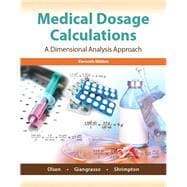For courses in medical dosage calculation in departments of nursing, pharmacy, pre-med, pre-dental, and other health disciplines; and for courses covering dosage calculation in other programs, such as pharmacology, pediatrics and critical care.
The complete and user-friendly guide to safe drug dosage calculation
Fully revised for current practices and medication, Medical Dosage Calculations remains the field’s most complete, user-friendly and accessible drug calculation text and workbook. Using the dimensional analysis format it pioneered, students begin with simple arithmetic, progressing to the most complex drug calculations. As they develop mathematical skills for accurate dosage calculations, they also gain a thorough professional understanding of safe drug administration. Compared with competitors, our text contains deeper, more realistic problems, incorporating actual dosages and requiring real critical thinking.








